Aluminum curtain wall coatings on 21st century façades
by Katie Daniel | December 4, 2015 10:09 am
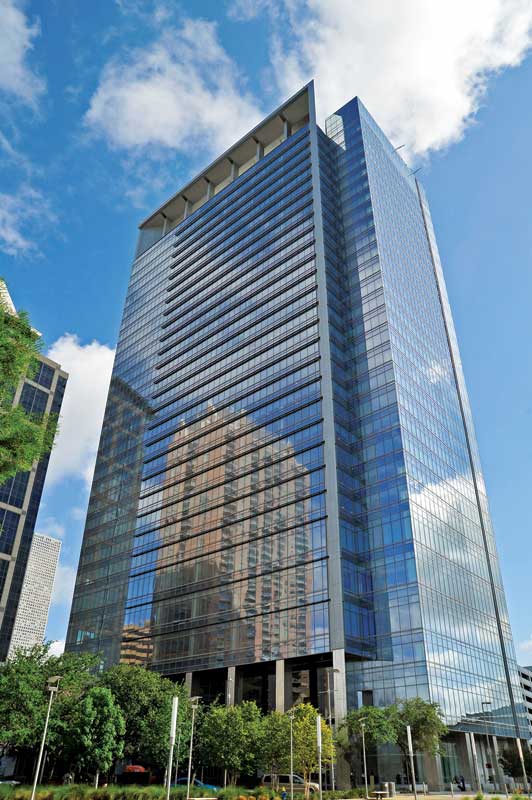 [1]
[1]By Ben Mitchell, CSI
Skyscraper cities, while conceptually rooted in mid-20th century architecture, are being reinvented to appeal to a new generation—and a new market. Their design is a topic of enduring interest in the world of architecture. The latest trend of supertall structures is defined by The Council on Tall Buildings and Urban Habitat (CTBUH) as taller than 300 m (984 ft). However, some recent towers exceed 609 m (2000 ft). When the Kingdom Tower in Jeddah, Saudi Arabia, opens in 2017, it will rise above 914 m (3000 ft).
U.S. cities, from San Francisco to Philadelphia to Boston, are experiencing their own booms in skyscraper construction, with a few earning supertall status. Growing populations, coupled with engineering advancements and a new confidence in the societal benefits of mixed-use ‘vertical cities,’ are sparking a design evolution that has not been seen in decades.
Skyscrapers contribute to a city’s marketability by offering unique, place-based experiences—attracting people and conferring prestige. When buildings become central to a city’s status and identity, their aesthetics take on a new level of importance. Building envelope design and materials are key to a structure’s artistic expression and can translate into its commercial and critical success, and this includes the architectural coatings specified.
In the post-WWII era, European tower blocks designed by well-known architects of the Modern movement provided inspiration for mid- and high-rise buildings around the world. However, because these towers lacked economic diversity and were often poorly constructed, most suffered a rapid demise. A few of these prototypes did endure, or even flourish, and they provide valuable lessons regarding the amenities that contribute to the longevity and success of a residential or mixed-use high-rise.
One building element retained from high modernism to fulfill this purpose is the curtain wall—those thin, typically aluminum-framed, systems with infill panels usually made of glass. With their lightness and flexibility, these non-loadbearing exterior walls not only provide the practical benefit of allowing more usable square footage within a building, but also epitomize upscale, modern construction.
Bringing curtain walls into the new century
Any aesthetic or functional deterioration of the curtain wall risks shortening the life span of a building or creating the need for extensive repairs. The expanse
of building surface area involved in high-rise architecture can make repair and refurbishment cost-prohibitive and can potentially involve liability. Even the appearance of building envelope degradation can reduce the success of a structure in the marketplace. Further, creating a durable curtain wall is important to the overall sustainability of a structure.
The main components of a typical curtain wall—glass and aluminum—have long service lives and can be expected to last throughout the life of the main (structural) building materials. However, the overall system could compromise sub-optimal performance of its other secondary components. This means considerations such as the building finish become crucial, and to ensure longevity in the finish, care should be taken in pretreating the aluminum (i.e. cleaning and treating the metal surface before painting) as well as selecting a coating.
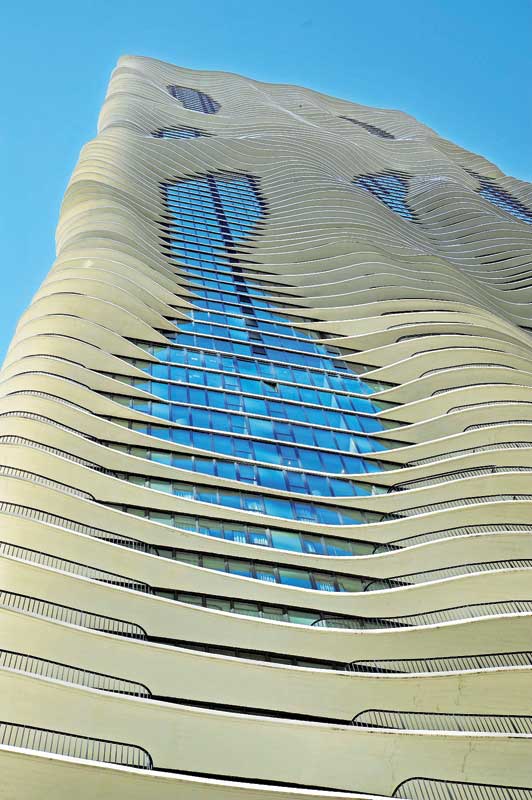 [2]
[2]Aluminum pretreatment
When pure aluminum corrodes, the result is aluminum oxide, a hard substance that forms a barrier on the aluminum surface and protects against further corrosion. However, architectural aluminum is usually an alloy, with magnesium (with or without silicon) being typical additives. Magnesium is added to allow tempering through heat treatment; silicon is added to increase flowability during extruding. When magnesium is present, magnesium oxide becomes a part of the film found on the surface of the aluminum. Magnesium is very reactive and dissolves in anything with a pH lower than 11. (Silicon oxide, on the other hand,
can be very inert and only dissolves in fluoride containing acids.)
Further, heat-treating aluminum alloys change their characteristics by forming a thin subsurface layer. The layer contains a higher concentration of alloying ingredients since the tempering causes a flow of alloying elements outward along the grain boundaries. The oxidized surface of an aluminum substrate is generally imperfect, with pores and other defects. Unless proper pretreatment takes place, corrosion of the building fenestration or cladding can occur when it is exposed to moisture and corrosive compounds.
Pretreatment methods include conversion coatings—part of the surface is converted into the coating using a chemical or electro-chemical process—or ‘dry-in-place’ coatings, in which non-reactive substances are applied in a thin film on the metal. A long-standing method of pretreatment is a conversion coating using chromium phosphate. Typically, the metal is first cleaned and slightly etched (with a surface removal of <0.5 g/m2 [<0.0001 lb/sf]) to help create an even conversion layer. Then the metal is rinsed, and the chromium is applied and rinsed off. The result is a conversion layer of about 1 g/m2 (0.0002 lb/sf) of chromium phosphate. Unfortunately, the chromium process is hazardous, with byproducts including chromic acid (a carcinogen), hydrofluoric acid (a poison), and phosphoric acid (a water pollutant).
To eliminate the use of chromium in the pretreatment process, some methods involve aggressive aluminum etching. This can involve either etching with acid alone, or first using an alkaline etch and rinse, followed by an acid etch and rinse. Acid etching is often the preferred method because it easily dissolves the magnesium and silicon alloying elements, and the process results in the best use of water, ease of waste treatment, and surface appearance.
Tests have shown the 2 g/m2 (0.0004 lb/sf) of aluminum surface removed by etching improves coating adhesion and greatly reduces under paint filiform corrosion. Filiform corrosion is a localized form of corrosion that manifests in threadlike ‘tunnels’ visible under the coating surface. This amount of etching coincides with the removal of the subsurface layer, which is normally 3 µm (0.1 mils) in thickness.
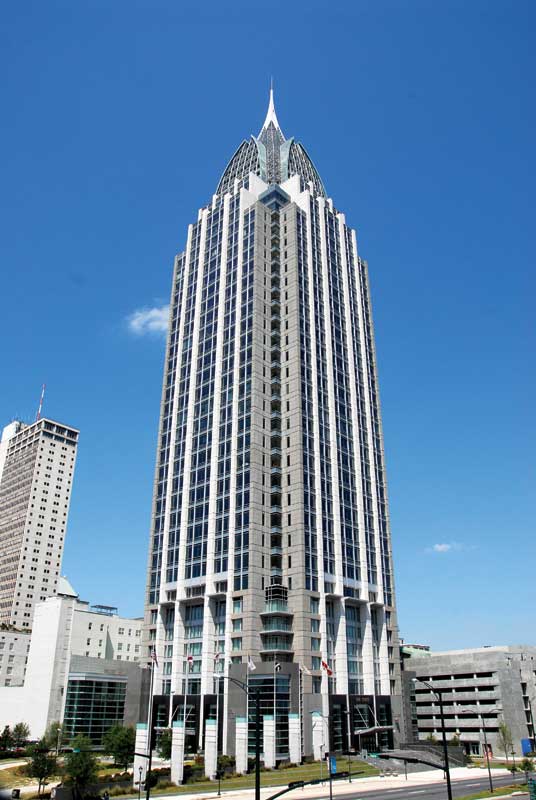 [3]
[3]Determining coating performance
Coatings that meet the highest standards, as defined by third-party organizations, should be used on structures with large expanses of structural glazed systems. Additional considerations—such as environmental concerns, ease of use, and color requirements—should be carefully weighed during the design process so a client’s needs can be met and the long-term success of the skyscraper can be ensured.
The standards of the American Architectural Manufacturers Association (AAMA are voluntary and include specifications, performance requirements, and testing procedures for pigmented organic coatings on aluminum extrusions and panels (for factory-applied organic coatings only). As defined by the AAMA specifications:
- AAMA 2603, Basic Pigmented Coatings, identifies pigmented organic coatings that will provide a good level of performance, highlighted by one year of Southern Florida weathering with the test panel positioned at a 45 degree angle;
- AAMA 2604, High Performance Coatings, focuses on high-performance organic coatings that will provide and maintain a high level of performance requiring a five-year Southern Florida weathering; and
- AAMA 2605, Superior Coatings, focuses on organic coatings that will provide and maintain a superior level of performance requiring a 10-year Southern Florida exposure.
Coatings meeting the AAMA 2605 standard are appropriate for use on high-end building exteriors and are expected to last the lifetime of the building.
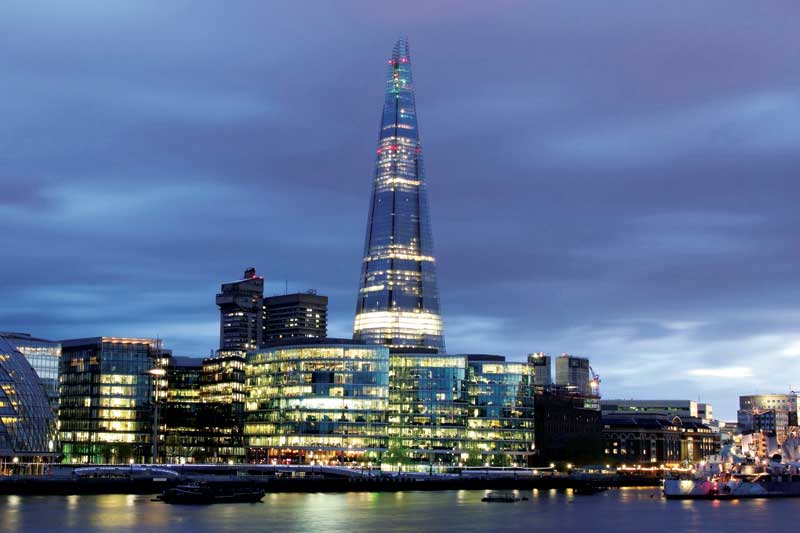 [4]
[4]Testing procedures for coatings
Procedures for testing architectural coatings include both mechanical tests—for example, testing the physical properties and film integrity—and exposure testing. Some issues, such as coverage, fall within the purview of quality control and are therefore not within the scope of performance testing.
Tests may include:
- impact resistance;
- adhesion;
- chemical resistance;
- humidity;
- salt-spray resistance;
- mortar resistance;
- acid resistance; and
- pencil hardness.
However, the most significant factor influencing a coating’s long-term performance is its weatherability—particularly its resistance against ultraviolet (UV) light.
Laboratory tests of painted panels conducted within cabinets using an artificial light source to simulate sunlight can provide some measure of a coating’s UV resistance. However, the most complete results are obtained in natural environments that provide exposure to the full spectrum of light in combination with other factors such as condensation, biological growth, and physical erosion not recreated in a laboratory cabinet.
Data from weather testing performed in Southern Florida is considered to be the global ‘gold standard’ of testing data. The subtropical climate in the region provides natural, realistic exposure to product specimens, yet results can be achieved on an accelerated timeline because one year of the region’s sunshine and moisture can equate to several years of exposure for other parts of the globe. The 45-degree south-facing exposure also makes the exposure more severe. The state offers high annual UV, high year-round temperatures, abundant rainfall, and very high humidity. Southern Florida exposure data is mandatory for AAMA (as well as for other quality organizations around the world).
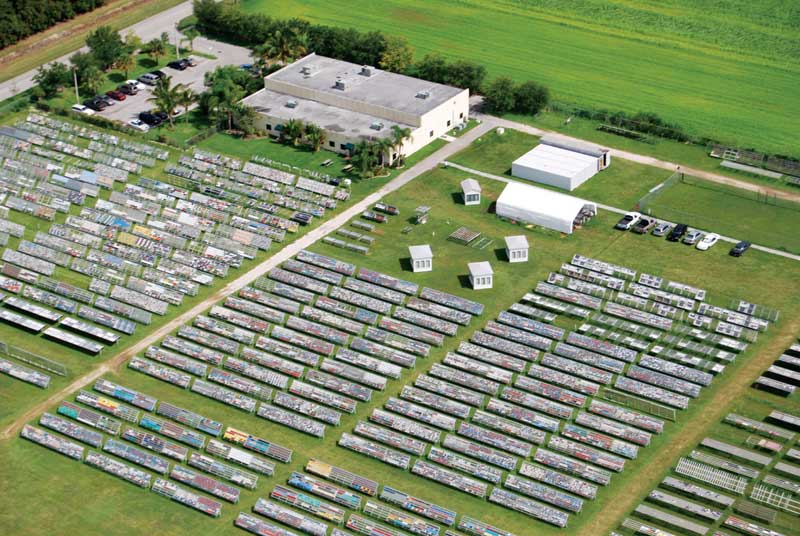 [5]
[5]AAMA 2603, 2604, and 2605 specify weathering testing involves exposing samples representing typical products on an exposure rack in Southern Florida south of latitude 27 degrees, north at a 45-degree angle, facing south, and inland at least 3.2 km (1.9 mi). At the end of the test periods, samples are evaluated for:
- film integrity;
- color retention;
- chalk resistance;
- gloss retention; and
- erosion resistance.
Florida is home to the largest outdoor weathering testing facility in the world. Various specimen mounting and exposure techniques are used to obtain accurate results; tests on exterior-use coatings are conducted using direct exposure. Test panels are mounted directly facing the sun, with varying angles and mounting techniques.
Coatings manufacturers usually work directly with a lab, conducting a series of tests that will provide the most complete set of data for a given product. Specimens are typically sent to the lab directly from the manufacturer’s research and development group. The testing lab then conducts the exposures and issues progress reports to the manufacturer. All testing is ‘blind’ so there is no bias in the data from the testing lab. Manufacturers then provide customers with the test data.
In an effort to collect more data faster, testing facilities are branching into different locations and different types of testing. Exposure facilities in the Arizona desert offer about 20 percent more sunlight, higher annual temperatures, and lower humidity than is typical in Florida. The increased UV and the extreme dry heat make Arizona the ideal location for testing highly durable materials intended for use in deserts around the world.
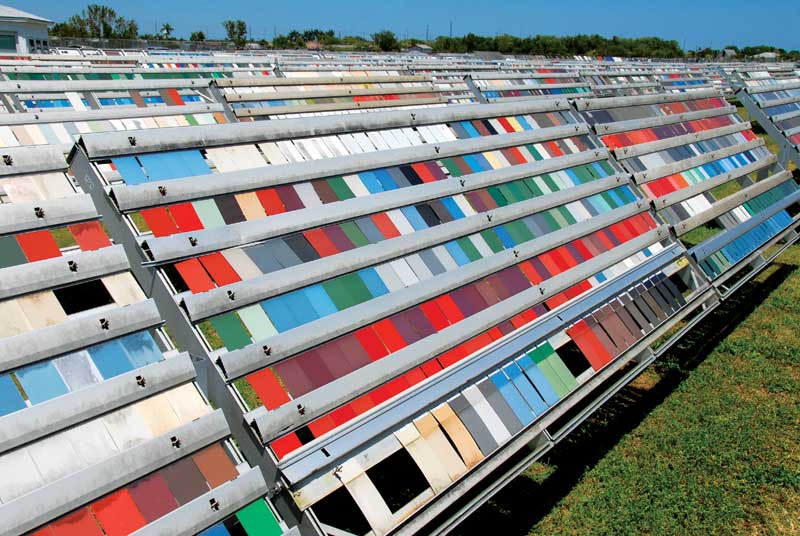 [6]
[6]Testing facilities can further accelerate the weathering process by using ‘concentrators’ with an array of mirrors to reflect and concentrate full spectrum sunlight onto test specimens. The concentrators are capable of tracking the sun throughout the day in both azimuth and elevation. The combination of mirrors and tracking maximizes the amount of UV exposure that a test specimen receives. These accelerated natural weathering devices can quickly produce extremely useful data concerning the durability of products. Depending on the product that is being tested, companies can specify ‘misting’ to simulate rainfall or morning dew. Again, this is for the purpose of simulating real-world installations.
What products meet the standards?
An expanding array of coatings options—both powder- and liquid-applied—can lead to confusion regarding which will comply with a given AAMA standard. Compounding the confusion is an erroneous belief powder-applied coatings are chemically different than their liquid-applied counterparts.
All paints, regardless of whether liquid or powder, are made of two principal ingredients: resin and pigment. Liquid paint has solvents that act as a vehicle to deliver the resin and pigment to the substrate. Powder coatings are applied in a finely ground form, without the use of solvents. It is the resin that provides the film with mechanical characteristics, such as gloss and gloss-retention, as well as resistance to abrasion, scratching, and dirt accumulation. Pigments provide the color of the painted surface, and are responsible for the color change or fade as they degrade over time. Regardless of whether a coating is applied as a liquid or powder, as long as the resin and pigment chemistry are comparable, the finish will meet the same weathering criteria.
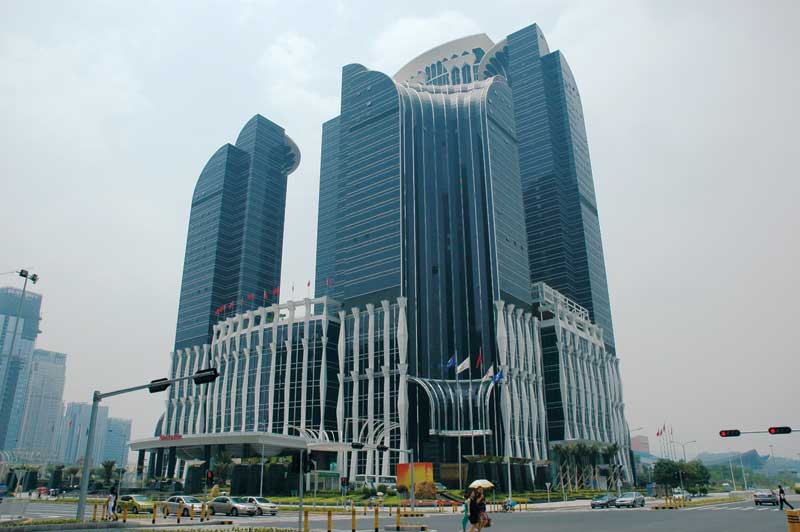 [7]
[7]Of the resin types most commonly used to coat aluminum substrates:
- conventional acrylic and high solids polyester liquid coatings, as well as standard durable polyester powder coatings, will meet AAMA 2603 requirements;
- silicone polyester and 50 percent polyvinylidene fluoride (PVDF) liquid coatings, as well as super-durable polyester powder coatings, will meet the requirements of AAMA 2604; and
- 70 percent PVDF liquid or powder coatings or fluoroethylene vinyl ether (FEVE) liquid or powder coatings will fulfill requirements for AAMA 2605.
Fluoropolymer resins are fluorocarbon-based polymers commonly referred to as ‘new generation’ coatings. The most widely known fluoropolymer resins available to the fenestration industry are PVDF and FEVE. Depending on the manufacturer, AAMA 2605 finishes are available with up to a 20-year warranty.
Put your finish first
The structural systems of skyscrapers have been almost completely reinvented since the building type’s early days—in fact, a continuing evolution of their structural systems is what allows skyscrapers to be built ever taller. Building envelope technology has seen incremental, not overarching development. Nevertheless, wall systems must be technologically sufficient to meet contemporary standards of durability. Secondary components of the system, such as finishes, also need to be carefully considered. By understanding state-of-the-art pretreatment method as well as the standards governing architectural coatings, and by specifying the correct coating for each skyscraper’s individual needs, the service life of the entire structure can be optimized.
Ben Mitchell, CSI, is the extrusion coatings sales and marketing manager for AkzoNobel, a global paints and coatings company and producer of specialty chemicals. He has a bachelor’s degree in comprehensive science from Urbana University in Ohio. Mitchell started at AkzoNobel in 1990 as a lab chemist formulating polyvinylidene fluoride (PVDF) coatings, before moving into product management. He can be contacted at ben.mitchell@akzonobel.com[8].
- [Image]: http://www.constructionspecifier.com/wp-content/uploads/2015/12/Hess-Tower.jpg
- [Image]: http://www.constructionspecifier.com/wp-content/uploads/2015/12/aqua-tower.jpg
- [Image]: http://www.constructionspecifier.com/wp-content/uploads/2015/12/RSA-Tower.jpg
- [Image]: http://www.constructionspecifier.com/wp-content/uploads/2015/12/The-Shard.jpg
- [Image]: http://www.constructionspecifier.com/wp-content/uploads/2015/12/Aerial.jpg
- [Image]: http://www.constructionspecifier.com/wp-content/uploads/2015/12/Testing.jpg
- [Image]: http://www.constructionspecifier.com/wp-content/uploads/2015/12/Sheraton.jpg
- ben.mitchell@akzonobel.com: mailto:ben.mitchell@akzonobel.com
Source URL: https://www.constructionspecifier.com/aluminum-curtain-wall-coatings-on-21st-century-facades/